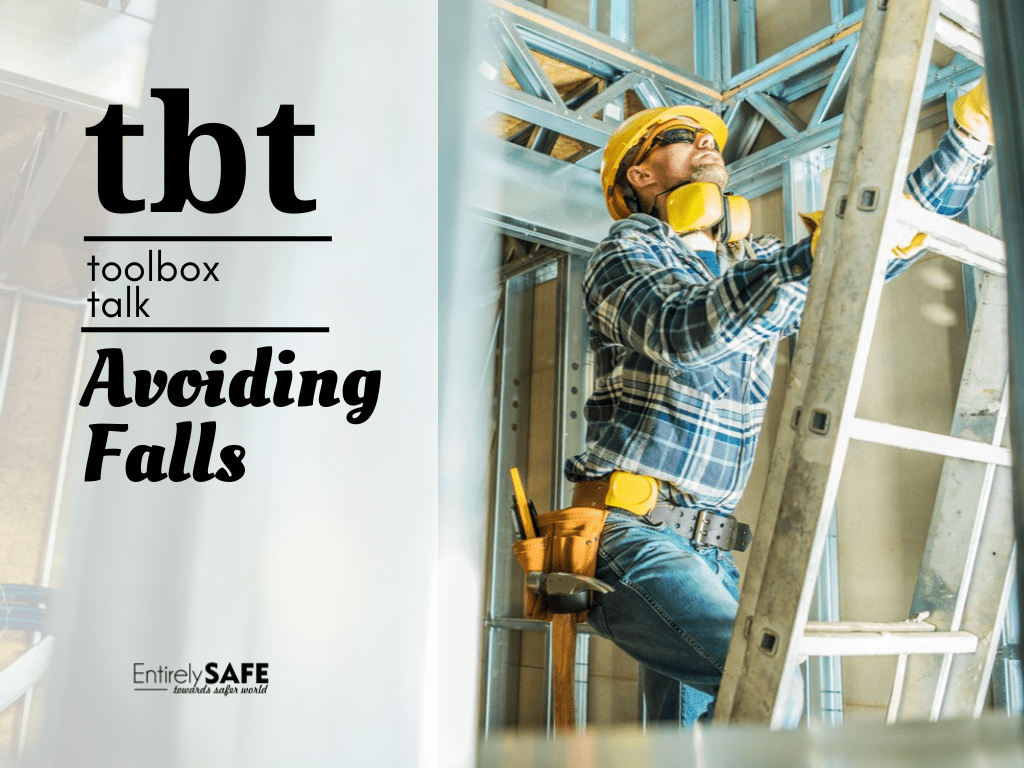Avoiding Falls Toolbox Talk

Before the Toolbox Talk
This safety talk is designed for discussion leaders to use in preparing safety meetings. Set a specific time and date for your safety meeting. Publicize your meeting so everyone involved will be sure to attend. Review this safety talk before the meeting and become familiar with its content.
Make notes about the points made in this talk that pertain to your workplace. You should be able to present the material in your own words and lead the discussion without reading it.
Seating space is not absolutely necessary, but arrangements should be made so that those attending can easily see and hear the presentation. Collect whatever materials and props you will need ahead of time. Try to use equipment in your workplace to demonstrate your points.
Give the safety talk in your own words. Use the printed talk merely as a guide. The purpose of a safety meeting is to initiate a discussion of safety problems and provide solutions to those problems. Encourage employees to discuss hazards or potential hazards they encounter on the job. Ask them to suggest ways to improve safety in their area. Don’t let the meeting turn into a gripe session about unrelated topics. As a discussion leader, it’s your job to make sure the topic is safe. Discussing other topics wastes time and can ruin the effectiveness of your safety meeting.

Toolbox Talk: Avoiding Falls
Many serious and fatal injuries are caused by falls. Everyone working on construction jobs must be alert to the hazards that can cause falls. If hazards are discovered, they should be reported to the supervisor and immediate action should be taken to eliminate them. The following are the hazards that cause the majority of falls in the construction industry. Let’s look at the ways to prevent or eliminate these hazards. Slippery areas, debris, lumber, and various hard materials and equipment scattered over the floor and construction site can cause serious falls. Proper housekeeping can eliminate these hazards and reduce falls caused by slipping, tripping, and stumbling.
Slippery floors caused by oil or grease spills or ice should be cleaned up immediately. Tools should be stored in a box or rack when not in use. Scrap and debris should be placed n a scrap container. Stairways and stairwells can also be serious hazards. Temporary handrails and barricade rails should always be placed on stairs and stairwells. Failure to use the handrail can result in a serious fall from the top to the bottom of the stairway. When going downstairs, keep your hand on the handrail so you can grasp it quickly to prevent a fall. Worn or broken threads on stairs are also slipping hazards. Replace any defective treads. Never place or store materials or tools on stairways.
Floor openings and pits should always be barricaded or covered with planking that is securely fastened in place. Ladder rails and rungs must always be of the proper design, material, and size. The ladder should never be used if the rails are cracked or the rungs are missing or broken. Ladders leading to landings or walkways should extend at least 36 inches above the landing and should be securely fastened. Long ladders must be braced at intermediate points. Improper placement of the ladder can result in a sudden shift, which could cause a fall.
The proper slope of a ladder is essential for maximum safety. Ladders should always be placed properly. The base of the ladder should be set at a distance of one-fourth the height of the ladder away from the wall or structure. Always make sure the ladder is solidly set before climbing it. If necessary, lay it in place to avoid shifting.
Always use two hands when climbing a ladder. Carrying objects in one hand can cause a sudden fall. Place both hands on the side rails, or rungs, whichever is surest for you. Keep a tool line in your pocket for raising or lowering tools or small objects. Ascending or descending a ladder backward is a sure way to head for trouble. Always face the ladder when climbing, descending, or working on it. Steel scaffolding should be erected and used in accordance with the manufacturer’s recommendations. Proper seating and locking of all connections and using the correct devices are extremely important.
All scaffolding must conform to the safety code design and be in strict compliance with material specifications and bracing. Where required, steel or wood scaffolds that are more than 4 feet high shall have toe boards and guardrails. Many serious falls can occur while hurrying. Walk, don’t run. Management can do everything possible to provide safe working conditions. But we need your help. Report any unsafe condition you discover immediately and follow the helpful suggestions we have discussed.
NOTE: If falls have occurred recently in your area, be prepared to discuss the accidents with your employees. Listen to their ideas; they may have the answer you have been looking for. Also, mention any hazards that may be peculiar to your particular operation.
Interactive Discussion
- Have you or someone you know been injured or nearly injured while carrying out this activity? What happened?
- How can we stay safe today?
- What do we do at the worksite to prevent injuries related to this activity?
After the Toolbox Talk
At the end of the meeting, ask employees to sign a sheet on the back of this talk as a record that they attended the safety meeting. Keep this talk on file for your records.

